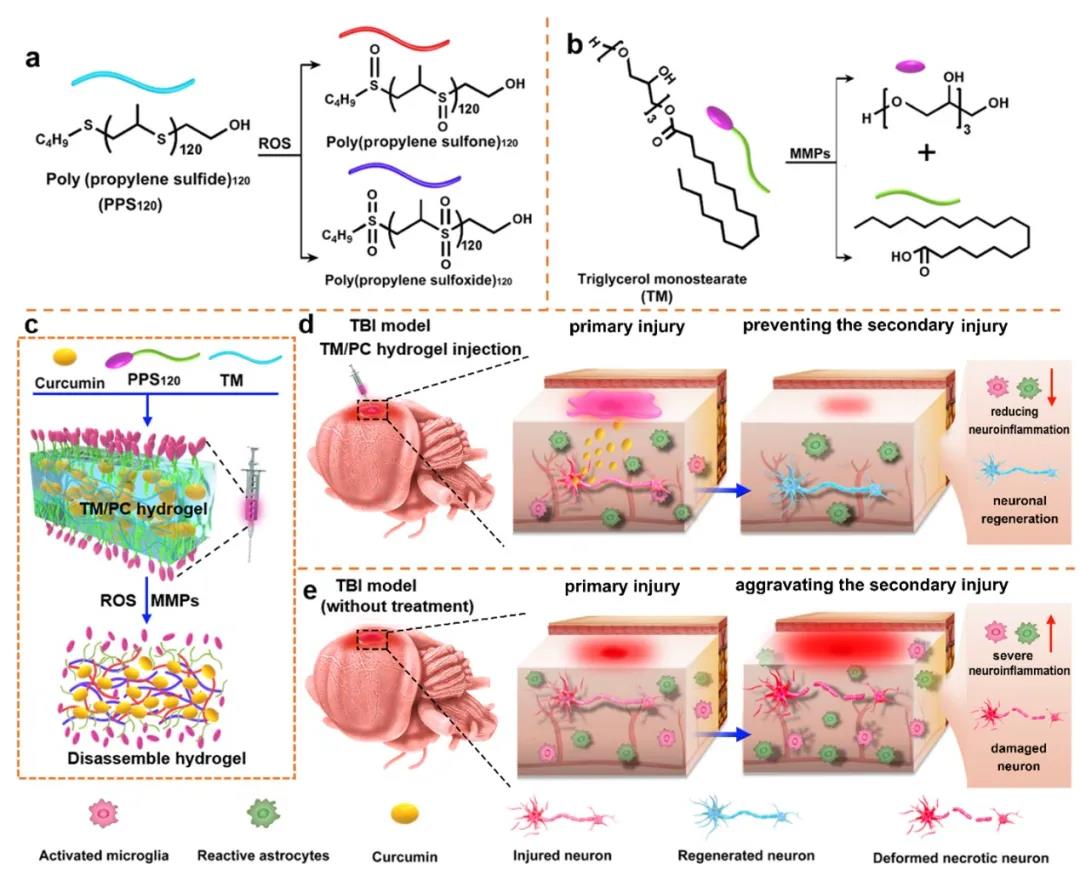Xuzhou Medical University Yu Yi/Liu Hongmei

Formation and mechanism of the TM/PC hydrogel in TBI Treatment. Traumatic Brain Injury (Traumatic Brain Injury, TBI) is one of the common diseases in neurosurgery, and it is one of the major health and socioeconomic problems in the world. Studies have shown that oxygen free radicals (ROS) are closely related to secondary brain damage after traumatic brain injury. This article first synthesized the PPS120 polymer with both ROS responsiveness and exhaustion of ROS. It was covered by matrix metalloproteinase (MMP) responsive monostearate triglyceride (TM) to form an injectable TM/P hydrogel. It is used to deliver neurotrophic drug curcumin for combined treatment of craniocerebral injury. On the one hand, the hydrogel itself can deplete ROS, reduce the level of ROS in brain tissue, and reduce neuroinflammation; on the other hand, the hydrogel disintegrates and releases curcumin in the microenvironment of brain trauma, and the released curcumin has an effect on cells. Oxidative stress regulates and plays a role in neurotrophic and repair. The test results show that the hydrogel can effectively respond to the neuroinflammatory microenvironment. At the same time, experiments in animals show that the hydrogel can also well inhibit neuro-inflammatory response and promote endogenous nerve repair, and exhibits good biocompatibility. In summary, we designed and prepared for the first time an anti-inflammatory hydrogel that can be used for postoperative treatment of traumatic brain injury, and is equipped with a neurotrophic drug curcumin for combined therapy, providing new strategies and new materials for early treatment of brain injury . The first authors of the paper are PhD student Qian Feng and master student Han Yuhan of Xuzhou Medical University. Professor Yu Qi and Associate Professor Liu Hongmei of Xuzhou Medical University are the corresponding authors of this article.
Professor Yu Yu of Xuzhou Medical University: Chief physician, second-level professor, doctoral supervisor. Dean of Brain Hospital, Director of Neurosurgery, Director of Glioma Treatment Center, Affiliated Hospital of Xuzhou Medical University; Young and middle-aged experts and medical leaders with outstanding contributions in Jiangsu Province, Jiangsu Province "Eleventh Five-Year Plan" period "Science, Education and Health Project "Excellent key talent, the first young and middle-aged science and technology leader in Jiangsu Province (the second level of "333" project), Jiangsu Province "Six Talent Peak" talents, Jiangsu Province labor model; served as the Neurotrauma Group of the Neurosurgery Branch of the Chinese Medical Association Member, member of the Standing Committee of the Neurological Injury Training Committee of the Chinese Medical Doctor Association, deputy chairman of the Glioma Professional Committee of the Chinese Anti-Cancer Association, member of the Standing Committee of the Neurological Trauma Professional Committee (Study Group) of the Trauma Branch of the Chinese Medical Association, and deputy of the Neurosurgery Branch of the Jiangsu Medical Association Chairman etc. Presided over more than 20 provincial and ministerial-level projects including 5 general projects of the National Natural Science Foundation of China and 2 key research and development projects of Jiangsu Province. The first completer won the first prize of the Jiangsu Science and Technology Award "Glioma Molecular Target Screening and The key technological innovation of transformation" and the first prize of Jiangsu Medical Science and Technology Award. Published more than 112 papers included in SCI, with a total impact factor of 386.868, and he cited 2260 times. He has published more than 200 papers in other core journals and 13 monographs.
Associate Professor Liu Hongmei of Xuzhou Medical University: Master supervisor, mainly engaged in the research of nano-carrier delivery of gene drugs, radiotherapy and chemotherapy drugs for the treatment of glioma and hydrogel drugs for the treatment of brain trauma. He presided over 10 topics including the National Natural Science Foundation of China, the Jiangsu Provincial Key Research and Development Program (Social Development) project, the Jiangsu Natural Science Foundation and the "Six Talent Peaks" of Jiangsu Province. Published 23 academic papers as the first author or corresponding author in SCI journals such as Biomaterials, ACS Applied Materials & Interfaces, Theranostics, Advanced Healthcare Materials, etc., with an h factor of 12 and a cumulative impact factor of 129.538 points. Authorized 5 Chinese invention patents. Won the first prize of Jiangsu Science and Technology Award and the first prize of Jiangsu Medical Science and Technology Award, and was awarded the title of Outstanding Young Scientist and Technologist by the Glioma Committee of the Chinese Medical Doctor Association. He is a member of the Medicine and Biotherapy Group of the Glioma Professional Committee of the Chinese Medical Doctor Association and a member of the Chinese Anti-Cancer Association.
This research was supported by the National Natural Science Foundation of China (81772665), Jiangsu Key R&D Project (BE2020647), Jiangsu Six Talent Summit Fund (2018-WSW-071), Xuzhou Medical University Youth Science and Technology Innovation Team Training Project (TD2020002) and Support for Xuzhou Key R&D Project (KC20079). Link to the paper: https://www.sciencedirect.com/science/article/abs/pii/S0142961221000260?via%3Dihub=
18915694570
Previous: Nano-scale COFs synthe


